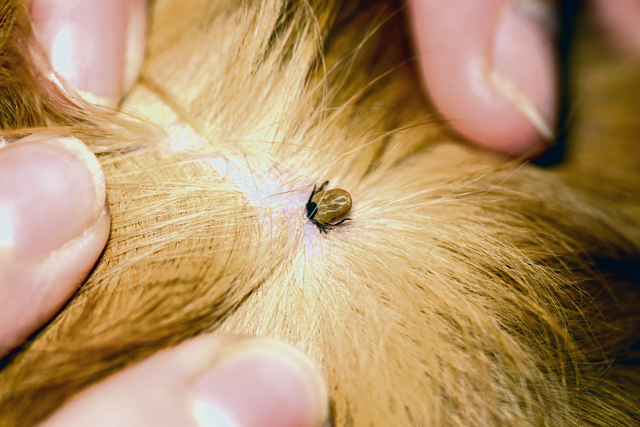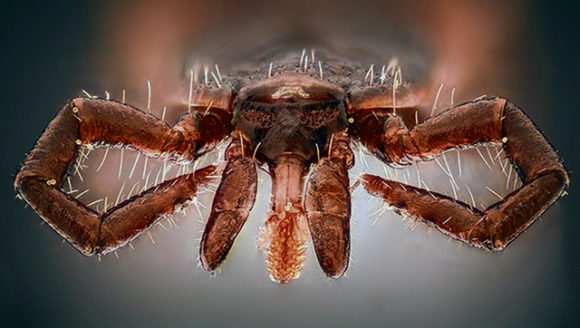by Michelle Thum
Tick exposure can occur year-round, but ticks are most active during the upcoming warmer months from March to September. Public Health Command Europe’s Entomology Department provides helpful tips and tricks for tick prevention.
“Ticks are pesky little critters and can carry several potentially serious diseases,” explained Lt. Col. Sheryl Pedersen, Chief of PHCE’s Entomology Department. “The most common disease ticks transmit is Lyme disease. A person with Lyme disease may develop fever, headache, fatigue and a skin rash.”
The red and circular rash is commonly referred to as “bulls-eye” rash but only approximately 70%-80% of infected persons develop the rash.
In most cases, Lyme disease can be treated with antibiotics. However, if the disease is left untreated, it can worsen and cause a number of serious problems, to include facial paralysis and pain and numbness in the hands and feet.
There is currently no Lyme disease vaccine available for humans. However, there is an effective vaccine available for Tick-borne Encephalitis that you can receive on the economy by referral.
“Ticks are most common during spring and summer, when the temperature is higher, but they adjusted well to the weather,” said Pedersen. “Nowadays, ticks can be spotted year-round, especially when the ground temperatures are above 45 degrees Fahrenheit.”
Ticks move quickly across the body, but they prefer areas that are warm and moist. They are often found in the armpits, groin, inside the belly button, at the back of the knees or the scalp. Once the tick has found a place it likes, it will bite and burrow its head firmly into the skin.
Pedersen says ticks can be safely removed with tweezers.
“The first thing to do is to make sure you remove it properly,” she said. “All you need is a pair of clean, fine-tipped tweezers and simply pull at the mouthparts, or as close to the skin as possible, in a slow steady manner. Don’t pull too abruptly since you can cause the body to disconnect from its head which will remain in your skin and cause an infection.”
Following removal, you should apply alcohol or an antibiotic ointment.
Prevention is also important in protecting yourself and your family. Here are five tips to prevent tick bites:
- Wear long-sleeved shirts and pants when in wooded areas.
- Wear closed shoes — no bare feet or sandals.
- Use an insect repellent with DEET.
- Don’t walk through bushes or tall grass. Stay on marked trails, where possible.
- After being outdoors, check for ticks. Shower and change your clothes.
Protecting yourself from ticks is important, but it is equally important not to forget about your furry family members.
Along with using tick prevention techniques,, pet owners are encouraged to check their pets for ticks daily, especially after they spend time outdoors.
Maj. Jamie Case, veterinarian and officer in charge of the Wiesbaden Veterinary Treatment Facility, recommends that pets be treated for ticks year-round and encourages pet owners to talk with their local veterinary treatment facility to determine the best tick prevention strategies.
 Igor Chus / Shutterstock.com
Igor Chus / Shutterstock.com Along with tick prevention, pet owners are encouraged to check their pets for ticks daily, especially after they spend time outdoors.
When checking your pet for ticks, don’t forget to check these five common places ticks hide on dogs:
- Under the collar: Make sure to remove your dog’s collar from time to time and inspect for ticks.
- Groin areas: Make sure to check in the groin area between the back legs and underneath the tail. These are popular spots for ticks to hide.
- Inside of Ears: All the little crevices inside of an ear make it a popular spot for ticks to hang out.
- Between toes: Spots like between the toes are cozy and not something that’s easy to see — making it a perfect place for a tick to set up camp.
- Near the eyelids: It can be tricky to tell, which is why around the eyes is one place ticks go unnoticed. If you’re not sure, it’s best to consult with your Veterinary Treatment Facility.
PHCE offers a free tick surveillance program, which identifies and tests ticks for the military and beneficiaries.
If you do find a tick on any member of your family, remove it and take the tick to your local medical treatment facility. For your furry friends, take the tick to a veterinary treatment facility. Be sure to have information on where you may have been bit and the date it was removed, so PHCE can capture the information.
Please do not send or bring ticks directly to Public Health Command Europe.
For more information on tick-borne illnesses and how to protect yourself and your family, please talk with your primary care manager or your pet’s veterinarian.
Follow “Public Health Command Europe” on Facebook.
Featured image by Cornel Constantin








